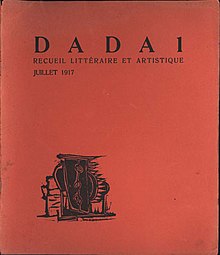
Back Dadaïsme Afrikaans Dadaismus ALS دادية Arabic دادا ARZ Dadaísmu AST Dadaizm Azerbaijani دادائیسم AZB Дадаізм Byelorussian Дадаізм BE-X-OLD Дадаизъм Bulgarian

| French art history |
|---|
| Historical periods |
| French artists |
| Thematic |
| Movements |
| See also |

Second row: Paul Dermée, Philippe Soupault, Georges Ribemont-Dessaignes.
Front row: Tristan Tzara (with monocle), Celine Arnauld, Francis Picabia, André Breton.


Dada (/ˈdɑːdɑː/) or Dadaism was an anti-establishment art movement that developed in 1915 in the context of the Great War and the earlier anti-art movement. Early centers for dadaism included Zürich and Berlin. Within a few years, the movement had spread to New York City and a variety of artistic centers in Europe and Asia. [2][3][4][5]
Within the umbrella of the movement, people used a wide variety of artistic forms to protest the logic, reason, and aestheticism of modern capitalism and modern war. To develop their protest, artists tended to make use of nonsense, irrationality, and an anti-bourgeois sensibility.[6][7][8] The art of the movement began primarily as performance[9] art, but eventually spanned visual, literary, and sound media, including collage, sound poetry, cut-up writing, and sculpture. Dadaist artists expressed their discontent toward violence, war, and nationalism and maintained political affinities with radical politics on the left-wing and far-left politics.[10][11][12][13] The movement had no shared artistic style, although most artists had shown interest in the machine aesthetic.[14]
There is no consensus on the origin of the movement's name; a common story is that the artist Richard Huelsenbeck slid a paper knife randomly into a dictionary, where it landed on "dada", a French term for a hobby horse.[15] Others note it suggests the first words of a child, evoking a childishness and absurdity that appealed to the group. Still others speculate it might have been chosen to evoke a similar meaning (or no meaning at all) in any language, reflecting the movement's internationalism.[16]
The roots of Dada lie in pre-war avant-garde. The term anti-art, a precursor to Dada, was coined by Marcel Duchamp around 1913 to characterize works that challenge accepted definitions of art.[17] Cubism and the development of collage and abstract art would inform the movement's detachment from the constraints of reality and convention. The work of French poets, Italian Futurists, and German Expressionists would influence Dada's rejection of the correlation between words and meaning.[18] Works such as Ubu Roi (1896) by Alfred Jarry and the ballet Parade (1916–17) by Erik Satie would be characterized as proto-Dadaist works.[19] The Dada movement's principles were first collected in Hugo Ball's Dada Manifesto in 1916. Ball is seen as the founder of the Dada movement.[20]
The Dadaist movement included public gatherings, demonstrations, and publication of art and literary journals. Passionate coverage of art, politics, and culture were topics often discussed in a variety of media. Key figures in the movement included Jean Arp, Johannes Baader, Hugo Ball, Marcel Duchamp, Max Ernst, Elsa von Freytag-Loringhoven, George Grosz, Raoul Hausmann, John Heartfield, Emmy Hennings, Hannah Höch, Richard Huelsenbeck, Francis Picabia, Man Ray, Hans Richter, Kurt Schwitters, Sophie Taeuber-Arp, Tristan Tzara, and Beatrice Wood, among others. The movement influenced later styles like the avant-garde and downtown music movements, and groups including Surrealism, nouveau réalisme, pop art, and Fluxus.[21]
- ^ World War I and Dada Archived 2017-12-01 at the Wayback Machine, Museum of Modern Art (MoMA).
- ^ "Dadaism in Berlin. The radical opponents of the establishment and their (Un)organised contradictions". 15 March 2013.
- ^ "Berlin Dada. The German Dada Artists of Berlin Club Dada Changed Modern Art. They Continue to Influence Modern Artist".
- ^ Francis M. Naumann, New York Dada, 1915–23 Archived 2018-10-28 at the Wayback Machine, Abrams, 1994, ISBN 0-81093676-3
- ^ Mario de Micheli (2006). Las vanguardias artísticas del siglo XX. Alianza Forma. pp. 135–137.
- ^ Trachtman, Paul. "A Brief History of Dada". Smithsonian Magazine. Archived from the original on 16 January 2017. Retrieved 14 January 2017.
- ^ Schneede, Uwe M. (1979), George Grosz, His life and work, New York: Universe Books
- ^ Budd, Dona (2005). The Language of Art Knowledge Cards. Pomegranate Communications. ISBN 9780764915994.
- ^ "Dada Performance".
- ^ Richard Huelsenbeck, En avant Dada: Eine Geschichte des Dadaismus, Paul Steegemann Verlag, Hannover, 1920, 1st ed. (Die Silbergäule): English translation in Motherwell 1951, p. [page needed]
- ^ "Dada, Tate". Archived from the original on 2014-10-26. Retrieved 2014-10-26.
- ^ Timothy Stroud, Emanuela Di Lallo, 'Art of the Twentieth Century: 1900–1919, the avant-garde movements', Volume 1 of Art of the Twentieth Century, Skyra, 2006, ISBN 887624604-5
- ^ Middleton, J. C. (1962). "'Bolshevism in Art': Dada and Politics". Texas Studies in Literature and Language. 4 (3): 408–430. JSTOR 40753524.
- ^ Lantz et al. 2016.
- ^ Ian Chilvers; John Glaves-Smith, eds. (2009). "Dada". A Dictionary of Modern and Contemporary Art. Oxford University Press. pp. 171–173. ISBN 9780199239658. Archived from the original on 2021-03-02. Retrieved 2021-02-13.
- ^ Dada Archived 2017-01-30 at the Wayback Machine, The art story, retrieved March 13, 2017.
- ^ "Anti-art, Art that challenges the existing accepted definitions of art, Tate". Archived from the original on 2017-04-05. Retrieved 2014-10-26.
- ^ "Dada", Dawn Adès and Matthew Gale, Grove Art Online, Oxford University Press, 2009 (subscription required) Archived 2018-03-12 at the Wayback Machine
- ^ Roselee Goldberg, Thomas & Hudson, L'univers de l'art, Chapter 4, Le surréalisme, Les représentations pré-Dada à Paris, ISBN 978-2-87811-380-8
- ^ "Hugo Ball: Founder of the Dada Movement". March 2020.
- ^ Oxford Dictionary of Modern and Contemporary Art, Oxford University, pp. 171-173